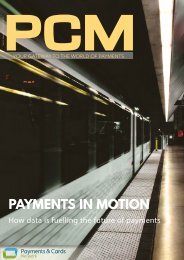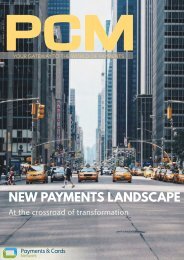PCM Vol.2 - Issue 6
You also want an ePaper? Increase the reach of your titles
YUMPU automatically turns print PDFs into web optimized ePapers that Google loves.
Thought Leaders Corner<br />
How is machine learning helping to tackle online fraud?<br />
It’s widely known in the financial services sector that<br />
criminals look for the weakest link in transactional<br />
systems for attempting fraud attacks. I was at the centre<br />
of UK banking when we rolled out Chip-and-PIN in the<br />
mid-2000s and saw the impact of this change on online<br />
fraud. With EMV rolling-out to the US last year, we’re<br />
already seeing online fraud spike – by 11% according<br />
to PYMNTS.com – as criminals perceive this channel<br />
as offering the biggest fraud ‘rewards’.To try and beat<br />
the criminals, financial services institutions need to<br />
understand all the data they’re collecting about their<br />
individual customers – and use this data for informed<br />
business decision-making. One term that we’re hearing<br />
used a lot to tackle analysing big data is ‘machine<br />
learning’. So what exactly is machine learning, and how<br />
is it being used to tackle online fraud?<br />
What is machine learning?<br />
In many industries – banking and payments included<br />
– machine learning has become a popular term. We’re<br />
particularly hearing it a lot in business areas that are already<br />
using advanced analytics methods to understand customer<br />
and business data.<br />
The promise of machine learning is that it can automate<br />
analysis processes – making it easier for financial services<br />
institutions to make decisions about their customers faster,<br />
and with more accuracy, than relying on human analysis alone.<br />
The kicker with machine learning is that the criminals are as<br />
sophisticated in these techniques as those of us who are trying<br />
to fight them off. It’s really tough to stay ahead, and we know<br />
that criminals look for the easiest targets when committing<br />
fraud. We need to beat them at their own game.<br />
Advanced computer science<br />
Machine learning is an area of computer science that studies<br />
how to make computers learn and improve with experience,<br />
with minimal human intervention. For example, being able<br />
to identify trends or patterns in large, complex quantities of<br />
data, with speed and accuracy – and then automatically adapt<br />
statistical models to incorporate these patterns and trends.<br />
This process enables computers to find insights from the data<br />
without being told where to look – this is what makes machine<br />
learning a branch of artificial intelligence.<br />
Fraud detection – detecting anomalies with machine<br />
learning<br />
So what does this mean for fraud detection and customer<br />
management? Well, the flip side of spotting and understanding<br />
data trends at high speed is that machine learning systems<br />
can also accurately and efficiently detect anomalies in these<br />
trends.<br />
This is crucial for fraud prevention. Human analysts are<br />
capable of looking at data to spot trends and anomalies, but<br />
do so very slowly. It takes us a long time to see the important<br />
changes in the data, and manually make adjustments to the<br />
007


















